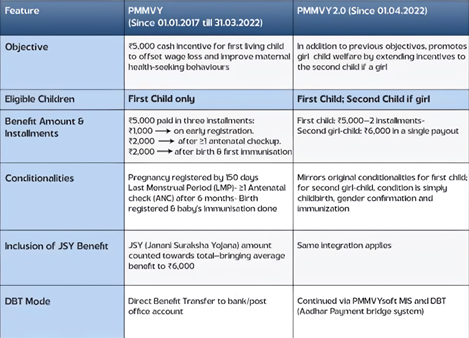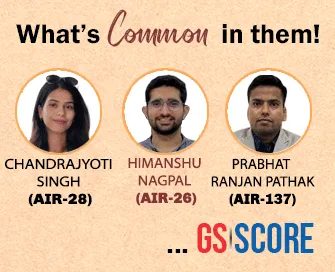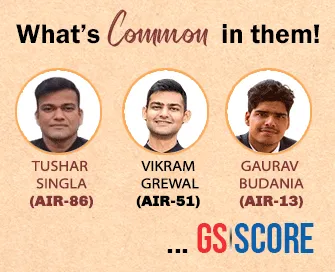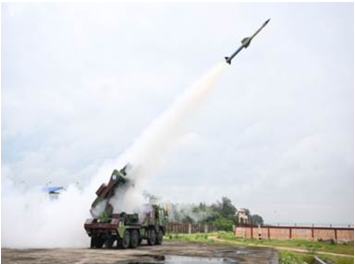

25th August 2025 (18 Topics)
Mains Issues
Context:
Government of India launched upgraded monitoring reforms under PMMVYexpanding PMMVY 2.0 benefits and linking them with Mission Shakti for women’s empowerment.
Key Dimensions of Pradhan Mantri Matru Vandana Yojana (PMMVY):
Genesis and Objectives
- Background
- Launched on 1 January 2017, under the Ministry of Women and Child Development (MWCD), as a maternity benefit scheme.
- Objectives

- Provide partial wage loss compensation to Pregnant and Lactating Mothers (PW&LM).
- Promote health-seeking behaviour among women.
- Encourage positive behavioural change towards the girl child (through benefits for the second girl child under PMMVY 2.0).
- Legal Backing
- Covers women under Section 4(b) of the National Food Security Act, 2013 (NFSA).
Features and Coverage
- Financial Assistance
- ?5,000 for the first child.
- ?6,000 additional for the second girl child (PMMVY 2.0).
- Linked with Janani Suraksha Yojana (JSY), total benefit ~?12,000.
- Eligibility
- Pregnant women & lactating mothers (PW&LM), except those in government jobs or availing similar benefits.
- Integration with Mission Shakti
- PMMVY falls under Samarthya sub-scheme, focusing on economic empowerment of women.
Monitoring, Transparency, and Technology
- Digital Platform (PMMVYSoft, 2023)
- Aadhaar authentication, NPCI verification, Direct Benefit Transfer (DBT).
- Biometric verification to prevent duplication/fraud.
- Transparency Tools
- Multilingual helpline 14408, automated SMS in 12 languages.
- Integrated grievance redressal system.
- Capacity Building
- Training programs for Anganwadi & ASHA workers.
- Awareness campaigns through IEC materials and video tutorials.
Achievements
- Nutritional Support: Helps combat maternal undernutrition and anaemia.
- Financial Security: Provides wage loss compensation, encouraging rest and recovery.
- Behavioural Impact: Incentivizes institutional deliveries and positive outlook towards the girl child.
- Digital Efficiency: Real-time tracking, DBT ensures transparency and reduced leakages.
Challenges
- Limited Coverage: Only ~40% of eligible women covered (NFHS-5).
- Exclusion Issues: Aadhaar-based authentication delays, exclusion of unregistered women workers.
- Insufficient Support: ?5,000 is inadequate to cover wage loss for informal sector workers.
- Implementation Gaps: Uneven awareness and administrative delays across states.
Way Forward
- Expand Coverage: Include second child irrespective of gender to ensure inclusivity.
- Enhance Financial Support: Align cash incentive with minimum wage levels.
- Strengthen Convergence: Integrate with POSHAN Abhiyaan, Ayushman Bharat, and state schemes.
- Community Awareness: IEC campaigns to address cultural barriers and low enrolment.
- Focus on Informal Sector Women: Design mechanisms for daily wage earners and migrant women.


Mains Issues
Context:
The Production Linked Incentive (PLI) Scheme has achieved investments of ?1.76 lakh crore by March 2025 across 14 sectors, generating over 12 lakh jobs and transforming India’s industrial base.
PLI: A Catalyst for India’s Manufacturing Renaissance
Genesis and Rationale of PLI Scheme
- Service-led Imbalance: India’s services sector contributes over 50% of GDP, while manufacturing remained at 15–17%, limiting job creation.
- Policy Response: PLI launched in April 2020 to boost self-reliance, scale up domestic industries, and integrate into global value chains.
- Initial Sectors: Began with mobiles, pharma APIs, and medical devices, later expanded to 14 sectors including automobiles, textiles, semiconductors, and white goods.
Sectoral Impact and Achievements
- Electronics & Mobile Manufacturing: Production surged 146% from ?2.13 lakh crore (FY 2021) to ?5.25 lakh crore (FY 2025); India emerged as a global smartphone hub.
- Automobile & EV Components: Investments of ?67,690 crore; incentives for 19 categories of Advanced Automotive Technology vehicles and 103 categories of components; aligned with FAME.
- Pharmaceuticals: Shift from net importer in FY 2021-22 (?1,930 crore deficit) to net exporter in FY 2024-25 (?2,280 crore surplus); domestic value addition at 83.7%.
- Semiconductors: Six approved projects and four new fabs; ?4,600 crore sanctioned; direct employment for 2,034 professionals; complements India Semiconductor Mission.
- Solar PV Modules: Nearly 48 GW of capacity planned; ?48,120 crore committed investment; ~38,500 direct jobs.
- Textiles & Food Processing: Support for MMF, technical textiles, and food processing; strengthening MSMEs and promoting exports.
Performance Outcomes
- Investment Mobilisation: ?1.76 lakh crore realised (March 2025).
- Production Growth: Sales by PLI participants exceeded ?16.5 lakh crore.
- Job Creation: Over 12 lakh direct and indirect jobs generated, including in Tier-2 and Tier-3 cities.
- Ecosystem Development: Creation of semiconductor parks, textile clusters in Surat, and medical device hubs in Andhra Pradesh and Tamil Nadu.
- FDI Attraction: Fresh inflows endorsed India as a preferred destination for high-value manufacturing.
Strategic Importance
- Self-Reliance: Reduces import dependency, especially in pharma APIs, semiconductors, and electronics.
- Global Competitiveness: Enhances India’s position in global value chains, particularly in electronics and renewable energy.
- Employment and Skill Creation: Anchors supply chains across MSMEs and generates skilled jobs.
- Green Economy Push: Boosts EV, solar, and energy-efficient appliances production, aligning with climate goals.
Challenges and Limitations
- Implementation Delays: Some projects face slow disbursement of incentives.
- Technology Gaps: Dependence on foreign technology in semiconductors and advanced components persists.
- Global Competition: Competing incentive regimes from countries like Vietnam, Mexico, and the U.S. (CHIPS Act).
- MSME Integration: Limited backward linkages in some sectors; needs stronger policy support.
Way Forward
- Faster Incentive Disbursal: Ensure time-bound approval and transparency to maintain investor confidence.
- Technology Upgradation: Encourage R&D, public–private partnerships, and technology transfer in frontier sectors.
- Cluster Development: Strengthen industrial corridors and dedicated clusters for semiconductors, EVs, and textiles.
- MSME Integration: Develop vendor development programmes linking MSMEs to anchor PLI units.
- Sustainability Focus: Incentivise green technologies, renewable energy, and circular economy models.


Prelims Articles
Context:
The transfer of archaeologist K. Amarnath Ramakrishna and disputes over his Keeladi excavation report have once again brought the Archaeological Survey of India (ASI) under public scrutiny regarding transparency and scientific integrity.
Keeladi Excavations – Significance
- Began in 2014; unearthed 7,500 artefacts under ASI and later 18,000 artefacts under the Tamil Nadu State Archaeology Department.
- Evidence suggests a literate, urban, secular society in the Vaigai Valley Civilisation.
- Bridges historical gap between the Iron Age (12th–6th BCE) and the Early Historic Period (6th–4th BCE).
- Linked to the Second Urbanisation of India (6th–2nd BCE).
Issues with ASI’s Approach
- Abrupt transfer of archaeologists (e.g., 2017 transfer of Ramakrishna) created suspicion of political interference.
- Delays in publishing excavation reports (e.g., Adichanallur and Sivagalai took >15 years).
- Selective emphasis on mytho-historical narratives (e.g., associating Rajasthan excavations with Saraswati River and the Mahabharata period) raises credibility concerns.
- Reliance on outdated Wheeler method, lack of comprehensive research designs, and absence of international peer review weaken scientific standards.
Global Best Practices and Needed Reforms
- International institutions like DeutschesArchäologischesInstitut (Germany) and INRAP (France) publish findings widely, ensuring transparency and scholarly engagement.
- Indian archaeology needs financial autonomy, modern methods (stratigraphy, AMS dating, GIS mapping), and pluralistic interpretation of the past.
- Structural reforms in ASI are necessary to prevent methodological nationalism and ensure an inclusive understanding of India’s diverse historical heritage.


Prelims Articles
Context:
Union Home Minister inaugurated the All India Speakers’ Conference at Delhi Assembly to mark 100 years of Vitthalbhai Patel becoming the first elected Indian President (Speaker) of the Central Legislative Assembly.
About Vitthalbhai Patel (1873–1933)
- First elected Indian President of the Central Legislative Assembly (1925).
- Elder brother of Sardar Vallabhbhai Patel.
- Played a crucial role in shaping India’s legislative traditions during colonial rule.
- Advocated independence of legislatures from executive control.
- Established the principle that Assemblies must remain impartial platforms of debate and legislation.
Significance of Central Legislative Assembly
- Created under the Government of India Act, 1919 (Montagu-Chelmsford Reforms).
- For the first time, Indians were allowed to preside over legislative institutions.
- Became a platform for nationalist leaders like Madan Mohan Malviya, Lala Lajpat Rai, and C.R. Das to articulate India’s aspirations for freedom.
- Set the foundation for the parliamentary system adopted after 1947.


Prelims Articles
Context:
The 130th Constitutional Amendment Bill has been introduced to mandate removal of Ministers, including the Prime Minister or Chief Ministers, if arrested and detained for 30 consecutive days in connection with a serious criminal offence.
Provisions of the Bill
- Amends Articles 75 and 164 (Union & State Council of Ministers) and Article 239AA (NCT of Delhi).
- A Minister arrested and detained for 30 consecutive days for an offence punishable with imprisonment of 5 years or more shall be removed from office.
- Removal may occur either on advice of PM/CM or automatically on the 31st day.
- If PM/CM is arrested similarly, they must resign on the 31st day.
- Such a person may be reappointed after release.
- Parallel amendments proposed for Jammu & Kashmir and Puducherry Union Territory legislations.
Existing Legal Framework
- Representation of the People Act, 1951 (RP Act):
- Section 8: Disqualification upon conviction for imprisonment ?2 years.
- Disqualification period: duration of sentence + 6 years.
- Section 8(4) exempted sitting MPs/MLAs if appeal pending, but struck down in Lily Thomas vs Union of India (2013).
- Presently, disqualification applies to legislators, not specifically to Ministers.
Concerns with the Bill
- Premature disqualification: Removal based on detention, not conviction, undermines the principle of innocent until proven guilty.
- Executive autonomy at risk: Limits the PM/CM’s discretion in cabinet formation, weakening parliamentary democracy.
- Risk of misuse: Police action could be manipulated for political vendetta against Ministers in opposition-ruled States.
Broader Issue – Criminalisation of Politics
- Reports by Association for Democratic Reforms (ADR):
- 46% of MPs and 45% of MLAs face criminal cases.
- Electoral success of candidates with criminal records is significantly higher than clean candidates (15.4% vs 4.4%).
- Real solution: Political parties must avoid fielding tainted candidates, ensuring internal reforms and electoral discipline.


Prelims Articles
Context:
The Jan Vishwas (Amendment of Provisions) Bill, 2025 was introduced in Lok Sabha to amend 16 Central Acts for decriminalisation and rationalisation of minor offences and penalties.
Background:
- The first Jan Vishwas Act, 2023decriminalised 183 provisions in 42 Central Acts across 19 ministries/departments.
- The new 2025 Bill expands the reform to 16 Central Acts under 10 ministries to promote ease of living and ease of doing business.
Why Needed:
- More than 75% of all crimes under Central laws relate to regulatory issues rather than serious offences.
- Over-criminalisation creates unnecessary burdens on the judicial system (India has 6 crore pending cases, out of which more than 2.3 crore cases are older than one year).
- Disproportionate criminal penalties discourage entrepreneurship, trade, and compliance.
What the Bill Proposes:
- 355 provisions amended –
- 288 decriminalised (focus on business regulations).
- 67 rationalised penalties.
- Affects 16 Central Acts, including:
- Reserve Bank of India Act, 1934
- Drugs and Cosmetics Act, 1940
- Road Transport Corporation Act, 1950
- Tea Act, 1953
- Handlooms (Reservation of Articles for Production) Act, 1985
- Motor Vehicles Act, 1988 (MVA)
- Legal Metrology Act, 2009 (LMA)
- Electricity Act, 2003, etc.
Key Features:
- Warning & Improvement Notice: For first-time offences under 10 Acts (e.g., Motor Vehicles Act, Apprentice Act, LMA).
- Penalty Instead of Imprisonment: For minor or technical offences (e.g., non-compliance under Electricity Act will now attract monetary fine instead of imprisonment).
- Rationalisation of Penalties: Higher penalties for repeated offences with automatic 10% increase every three years (deterrence mechanism).
- Business-Friendly Measures: Simplifies compliance, reduces litigation, lowers pendency, promotes trust-based governance.
Significance:
- Strengthens Atmanirbhar Bharat agenda by fostering ease of doing business.
- Helps in judicial reforms by reducing burden on courts.
- Encourages a predictable regulatory environment while ensuring deterrence for repeated violators.


Prelims Articles
Context:
A new study has revealed that while Arctic sea ice melting has slowed down in the past 20 years, the slowdown is temporary and melting is expected to accelerate again.
Background:
- Melting of Arctic sea ice is one of the most visible indicators of global climate change.
- The slowdown in ice loss is observed over the last two decades, but it does not imply recovery of the Arctic.
Reasons for Slowdown:
- Anthropogenic Global Warming: Human activities such as fossil fuel burning have led to higher greenhouse gas emissions, contributing to Arctic ice melting.
- Natural Climate Variability: Cyclical variations in the Earth’s climate system also influence ice melt rates.
- El Niño-Southern Oscillation (ENSO): Alters atmospheric circulation and affects Arctic conditions.
- Pacific Decadal Oscillation (PDO): Long-term fluctuations that can bring cooler waters to Arctic regions.
- Atlantic Multidecadal Variability (AMV): Fluctuations in North Atlantic sea surface temperatures influence ice melt.
Key Findings of Study:
- The pace of melting slowed to 0.35 million sq. km per decade in the last 20 years, compared to 1.3 million sq. km per decade between 1993–2012.
- The slowdown is likely temporary (may continue for another 5–10 years).
- Once slowdown ends, models predict an accelerated loss of 0.6 million sq. km per decade.
Implications:
- The slowdown does not mean climate change is reversing; global GHG levels and mean global temperatures continue to rise.
- The Arctic may witness sharper, more rapid melting after the slowdown phase.
- Accelerated sea ice loss impacts:
- Albedo Effect: Less ice means more absorption of heat, enhancing warming.
- Ecosystems: Threat to species such as polar bears and Arctic biodiversity.
- Weather Extremes: Disruption of global atmospheric circulation affecting monsoons, storms, and rainfall.
- Sea-Level Rise: Though Arctic sea ice melting contributes less directly to sea level rise (since it is floating ice), it indirectly accelerates Greenland ice sheet melting.


Prelims Articles
Context:
A new study in Nature Ecology & Evolution has estimated that invasive alien plants and animals have caused over $2.2 trillion in global economic losses, with India showing the highest underreporting in management costs.
Economic Impact:
- Global cost of biological invasions: $2.2 trillion (1960–2022).
- Europe bears the highest cost (~$1.5 trillion, 71.45% of global total).
- India’s management expenditure discrepancy is the highest (1.16 billion %), indicating severe underreporting.
Invasive Species with Highest Costs:
- Plants: $926.38 billion.
- Arthropods: $830.29 billion.
- Mammals: $263.35 billion.
- Examples:Japanese knotweed (Reynoutria japonica) and Lantana camara are among the most costly to manage.
Drivers of Invasion:
- Trade, travel, globalisation, and import of living organisms.
- Agricultural crops themselves are often non-native, complicating management.
Control Measures & International Frameworks:
- Ballast Water Management Convention (International Maritime Organization): prevents spread of harmful aquatic organisms.
- Convention on Biological Diversity (CBD): obliges member states (including India) to prevent, control, or eradicate alien invasive species.
Challenges for India:
- Lack of centralized database and inter-agency coordination.
- Limited resources and competing conservation priorities.
- Significant “hidden” costs due to poor documentation and underreporting.


Prelims Articles
Context:
Illegal and unregulated mining in the Aravalli range of Haryana and Rajasthan has caused severe health, ecological, and groundwater problems despite repeated Supreme Court bans.
Aravalli Range – Geography and Significance
- Oldest fold mountain range of India, running through Haryana, Rajasthan, Delhi, and Gujarat.
- Functions as an important ecological barrier against desertification from the Thar Desert.
- Rich in minerals such as sandstone, marble, granite, copper, lead, zinc, tungsten, and gold.
- Provides aquifers, lakes, and forest ecosystems that support biodiversity and human livelihood.
Environmental Degradation
- Mining, both legal and illegal, has damaged aquifers, dried up lakes, and reduced groundwater recharge.
- Stone crushers and cement plants have caused air pollution leading to silicosis, respiratory illnesses, and skin diseases.
- Continuous dust and heavy vehicular movement worsen the air quality in villages near quarries.
- Migration from affected villages reflects socio-economic stress caused by environmental degradation.
Legal and Policy Measures
- 2009: Supreme Court imposed a blanket ban on mining in Faridabad, Gurugram, and Mewat (Nuh) districts of Haryana.
- May 2024: Court prohibited granting of fresh mining leases or renewals in the entire Aravalli range.
- Despite orders, illegal mining continues, reflecting enforcement challenges.
- Compensation framework: Victims of silicosis in Rajasthan are eligible for ?3 lakh; heirs receive ?2 lakh in case of death.
Government Initiatives
- Aravalli Green Wall Project: Launched in June 2025, aims to create a 5 km-wide green buffer zone across the range to curb desertification and improve green cover.
- National and state-level policies focus on reforestation, ecological restoration, and stricter monitoring.


Prelims Articles
Context:
The Indian Council of Medical Research (ICMR) will expand wastewater surveillance to monitor 10 viruses across 50 Indian cities in the next six months, strengthening early detection of infectious diseases.
Concept of Wastewater-Based Epidemiology (WBE):
- WBE detects fragments of viruses or bacteria in wastewater shed by infected individuals, including asymptomatic and pre-symptomatic persons.
- Provides early warning signals of community-level outbreaks before clinical symptoms are widely reported.
Current Plan in India:
- ICMR already monitors COVID-19 and Polio virus in 5 cities.
- Surveillance will be scaled up to 50 cities for 10 viruses, including those linked with fever, diarrhoea, encephalitis, and respiratory distress.
- Environmental surveillance also includes Avian Influenza Virus (AIV) through monitoring of surface and wastewater in outbreak areas.
Existing Surveillance Systems in India:
- Integrated Disease Surveillance Programme (IDSP) and ICMR track Influenza-Like Illness (ILI) and Severe Acute Respiratory Illness (SARI).
- WBE will complement these by providing non-invasive, cost-effective, near-real-time data on infections.
Global Context and Importance:
- Post-COVID-19, wastewater surveillance is seen as a predictive tool for pandemic preparedness.
- The WHO and UNEP support wastewater surveillance for both public health security and ecosystem protection.
- Helps identify transmission hotspots, allocate resources, and monitor water quality to safeguard freshwater and marine ecosystems.
Advantages for India:
- Covers large populations at relatively low cost.
- Useful in densely populated and urban areas with rapid pathogen transmission.
- Supports One Health approach, linking human, animal, and environmental health.


Prelims Articles
Context:
India celebrated National Space Day 2025, where Union Minister Dr. Jitendra Singh unveiled the 15-year space roadmap with over 100 planned satellite launches and future human spaceflight missions, aligning with the vision of Viksit Bharat 2047.
National Space Day
- Observed annually to commemorate India’s achievements in space and future roadmap.
- 2025 theme: “Aryabhatta to Gaganyaan: Ancient Wisdom to Infinite Possibilities”.
- Celebrations included recognition of student innovators in BharatiyaAntariksh Hackathon and ISRO Robotics Challenge.
India’s Space Roadmap (2025–2040)
- Launch of 100+ satellites, 70% of them small satellites.
- Expansion of public–private partnerships with increasing role of startups.
- Strengthened space applications for food, water, disaster resilience, and governance.
Key Upcoming Missions
- 2025: Human-robot mission Vayumitra.
- 2027: First human spaceflight (Gaganyaan).
- 2028: Chandramitra
- Chandrayaan-4 and mission to Venus in pipeline.
- 2035: Establishment of Bharat Antariksh Station.
- 2040: Planned Indian astronaut landing on the Moon.
Institutional Developments
- IN-SPACe (Indian National Space Promotion and Authorization Centre) facilitates private sector participation.
- 300+ stakeholder consultations resulted in 15-year roadmap.
- ISRO now acts as both a technology developer and facilitator for private sector-led missions.
Significance for India
- Enhances India’s role as a trusted partner in global space missions.
- Expands space technology applications in governance (e.g., smart cities, disaster management, land ownership mapping).
- Encourages innovation through youth participation in hackathons and robotics challenges.


Prelims Articles
Context:
The Indian Space Research Organisation (ISRO) successfully conducted a parachute system test of the Gaganyaan crew module, a crucial step for India’s first human spaceflight mission.
About Gaganyaan Mission:
- India’s first human spaceflight programme being developed by ISRO.
- Aim: To demonstrate the capability to send humans into low-earth orbit (~400 km) and return safely.
- Planned crew size: 2–3 astronauts (Vyomnauts).
Recent Development:
- ISRO tested the parachute system of the crew module at Sriharikota.
- The parachute system ensures safe deceleration and landing of astronauts after re-entry.
- Dummy module was air-dropped from ~3 km altitude by a Chinook helicopter to validate parachute deployment.
Key Technologies Involved:
- Crew Module (CM):Pressurised chamber that will house astronauts.
- Crew Escape System (CES): Provides emergency escape in case of launch failure.
- Re-entry Technology: Heat shield protects astronauts from extreme temperatures (~2700°C) during re-entry.
- Parachute Recovery System: Enables safe splashdown in sea.
Future Plans:
- Multiple unmanned missions (with humanoid "Vyommitra") will precede the manned flight.
- First crewed Gaganyaan mission targeted after completion of all safety validations.
Significance:
- Positions India as the fourth nation after Russia, USA, and China to undertake human spaceflight.
- Boosts indigenous technological capabilities in aerospace, robotics, life sciences, and materials engineering.
- Contributes to Atmanirbhar Bharat and strategic self-reliance in critical technologies.


Prelims Articles
Context:
INS Kadmatt, an indigenous Anti-Submarine Warfare (ASW) corvette, completed a three-day port call at Surabaya, Indonesia to enhance maritime cooperation and interoperability between the Indian Navy and the Indonesian Navy.
INS Kadmatt (ASW Corvette)

- Belongs to Kamorta-class (Project 28) Anti-Submarine Warfare corvettes.
- Designed and built by Garden Reach Shipbuilders and Engineers (GRSE), Kolkata.
- Equipped with state-of-the-art ASW sensors, torpedoes, and RBU-6000 rocket launchers.
- Reflects India’s indigenous shipbuilding capability under Atmanirbhar Bharat.
India–Indonesia Maritime Cooperation
- Part of the shared vision of “Partnership Across the Sea”, focusing on secure sea lanes and freedom of navigation.
- Engagements included professional exchanges, cross-deck visits, yoga sessions, and sports activities with TNI AL (Indonesian Navy).
- Strengthens trust, interoperability, and operational synergy in the Indo-Pacific.
Strategic Importance
- Indonesia is a key maritime partner, located at the confluence of Indian and Pacific Oceans.
- Both nations are members of Indian Ocean Rim Association (IORA) and cooperate in forums like ASEAN Defence Ministers’ Meeting Plus (ADMM-Plus).
- The visit reaffirms India’s role as a “preferred security partner” in the region, consistent with India’s SAGAR (Security and Growth for All in the Region)


Prelims Articles
Context:
DRDO successfully conducted the maiden flight-tests of Integrated Air Defence Weapon System (IADWS) off the Odisha coast on 23rd August 2025.
About IADWS
- The Integrated Air Defence Weapon System (IADWS) is a multi-layered air defence system designed to counter aerial threats.
- It integrates:
- QRSAM (Quick Reaction Surface-to-Air Missiles) – for medium-range interception.
- VSHORADS (Very Short Range Air Defence System) – for close-range threats.
- High-power Laser-based Directed Energy Weapon (DEW) – for precision neutralisation of drones/UAVs.

- Operated by a Centralised Command & Control Centre, developed by Defence Research & Development Laboratory (DRDL), Hyderabad.
- Other DRDO labs involved:
- Research Centre Imarat (RCI) – VSHORADS development.
- Centre for High Energy Systems and Sciences (CHESS) – DEW development.
Significance of the Test
- Validated simultaneous destruction of multiple aerial targets (fixed-wing UAVs, multi-copter drones) at different ranges and altitudes.
- Establishes India’s indigenous, layered air defence capability against evolving threats, including drones and unmanned systems.
- Strengthens area defence for critical infrastructure, military bases, and strategic assets.
- Complements existing systems like Akash, Barak-8, S-400 (imported), creating a mix of indigenous and foreign systems.


Prelims Articles
Context:
The Indian Air Force reportedly deployed the X-Guard Fibre-Optic Towed Decoy (FOTD) system duringOperation Sindoor, showcasing the growing role of deception technologies in contemporary warfare.
Concept and Utility of Decoys
- Decoys are systems designed to mislead enemy sensors, radars, and munitions by imitating the signatures of real combat platforms.
- They absorb enemy missile strikes, waste ammunition, and protect actual assets, making them cost-effective force multipliers.
- Categories: airborne decoys (fighter jets, UAVs), land-based decoys (inflatable tanks, artillery replicas), and naval decoys (acoustic/missile decoys).
Airborne Decoys – Indian Context
- India’s Rafale fighters reportedly used X-Guard FOTD developed by Israel’s Rafael.
- Features: 30 kg, lightweight, retractable, reusable, mimics radar cross-section (RCS), velocity, and spectral signatures of the Rafale.
- Integrated with Rafale’sSPECTRA EW suite, offering a multi-layered defensive shield.
- Comparable global systems: BriteCloud (Leonardo, UK/Italy), AN/ALE-50/55 (Raytheon/BAE, USA), adaptable also for drones.
Land and Naval Decoys
- Land-based decoys simulate tanks, artillery, or missile batteries using radar-reflective, heat-emitting, or 3D-printed models. Widely used in the Gulf War (1991), Russia-Ukraine conflict, and by China and the U.S.
- In 2025, the Indian Army issued an RFI for decoys of its T-90S/SK tanks replicating thermal and acoustic signatures.
- Naval decoys include floating chaff, acoustic devices, and the Nulka active missile decoy (Australia–U.S. collaboration), which mimics large warships to divert radar-guided missiles.


Editorials
Context:
The Constitution (One Hundred and Thirtieth Amendment) Bill, 2025, was introduced in the Lok Sabha on August 20, 2025, mandating resignation or automatic removal of Ministers, Chief Ministers, and the Prime Minister if in custody for over 30 consecutive days in crimes punishable with five years or more imprisonment.
Constitutional and Judicial Foundations
- Constitutional Basis: The Bill draws on Articles 75, 164, and 239AA, which vest ministerial tenure in the “pleasure” of the President or Governor, subject to constitutional morality.
- Judicial Interpretations: Landmark judgments such as Shamsher Singh, NabamRebia, and R. Bommai underscore constitutional morality, integrity, and accountability as guiding principles in governance.
- Ethical Dimension of Appointments: In Manoj Narula vs Union of India, the Supreme Court warned against appointing individuals facing serious criminal charges as Ministers, highlighting morality as integral to constitutional design.
Constitutional and Political Concerns
- Presumption of Innocence: Automatic removal on detention challenges Article 21, since disqualification under the Representation of the People Act occurs only upon conviction, as clarified in Lily Thomas vs Union of India.
- Executive Discretion and Political Risks: The dual mechanism of removal—advice-based or automatic—may politicise accountability, enabling partisan shielding or targeting of Ministers.
- Inconsistency in Treatment: Legislators face disqualification only upon conviction, but Ministers would be ousted on mere detention, creating asymmetry and undermining constitutional consistency.
Structural Limitations and Alternatives
- Revolving Door Instability: The provision allowing reappointment post-release could create cycles of resignation and reinstatement, generating political instability without ensuring accountability.
- Need for Nuanced Model: Reform could link removal to judicial milestones like framing of charges, ensuring judicial scrutiny prevents politically motivated arrests.
- Targeted Safeguards: Limiting the Bill’s scope to offences of moral turpitude and corruption, along with independent review mechanisms, would balance ethical governance with due process.
Practice Question
The Constitution (One Hundred and Thirtieth Amendment) Bill, 2025, seeks to address the problem of criminalisation in politics by mandating resignation or removal of Ministers under detention. Critically examine the constitutional, ethical, and political implications of such a framework. Suggest alternatives that balance integrity in governance with democratic safeguards. (250 words)


Editorials
Context:
India is prioritising early childhood nutrition and cognitive development through initiatives like PoshanBhiPadhaiBhi and Navchetana, recognising the first 1,000 days as critical for lifelong growth.
Science of Early Childhood
- Brain Development Window: By age two, a child’s brain reaches 80% of adult weight, with synapse formation and frontal lobe growth peaking in the first 1,000 days.
- Irreversible Nutritional Deficits: Deficiencies before age three can cause permanent stunting and cognitive damage; at the current decline rate, India will reach 10% stunting only by 2075.
- Nutrition–Cognition Link: Studies, including the Vellore birth-cohort, show that iron deficiency hampers verbal skills and processing speed, highlighting the need for combined nutrition and stimulation programmes.
Policy Interventions in India
- Integrated Child Development Services (ICDS): As one of the world’s largest childcare programmes, ICDS provides nutrition and learning support through Anganwadi centres across India.
- PoshanBhiPadhaiBhi Initiative: Launched by the Ministry of Women and Child Development, it integrates nutrition and cognitive development as joint priorities in early childhood care.
- Navchetana Framework: This framework provides 140 structured activities in a 36-month calendar for parents, caregivers, and Anganwadi workers to ensure age-appropriate stimulation.
Gaps and Way Forward
- Strengthening ICDS Delivery: Despite 14 lakh Anganwadi centres, gaps in coverage, quality, and urban service delivery persist, demanding technology-driven and inclusive expansion.
- Pre-Primary Education and Monitoring: Improved access, evaluation, and psychosocial assessment of children under six years are essential to ensure holistic early childhood development.
- Expanding Crèche Models: Public, community-based, and public–private partnership models of crèches are needed to empower women’s workforce participation while supporting child care.
Practice Question
“The first 1,000 days of a child’s life are critical for nutrition and cognitive development.” Discuss the scientific, policy, and socio-economic dimensions of this statement in the Indian context. Suggest measures to strengthen early childhood care frameworks. (250 words)


Editorials
Context:
The recent U.S. decision under President Donald Trump to impose 50% tariffs on Indian goods and reset strategic parity between India and Pakistan has posed major foreign policy challenges for India.
U.S. Policy Shift and Implications
- Regressive American Actions: The U.S. tariff hike and Pakistan parity reset mirror past unilateral steps like the nuclear sanctions of 1998, creating obstacles for India’s rise as a major power.
- Strategic Autonomy Pursuit: India’s long-term foreign policy goal is rooted in strategic autonomy, hedging strategies, and equal recognition from great powers, making it resilient to external pressures.
- Testing of Rising Powers: Major powers historically endure external tests and provocations; India too must withstand setbacks, balance partnerships, and respond with assertive confidence.
Regional Dynamics and Risks
- Pakistan’s Provocative Tendencies: Pakistani elites, backed by China and opportunistic support from Washington, may exploit the situation by heightening provocations and destabilising actions.
- India’s Security Concerns: Heightened conflict with Pakistan and border threats with China increase costs for India, limiting its naval power and ambitions in the Indo-Pacific.
- Domestic Economic Burden: To maintain resilience, India must absorb external shocks like tariffs and balance rising defence and economic costs while avoiding diplomatic isolation.
Pathways for India’s Strategy
- Recalibrating Multi-Alignment: India must reorient its multi-alignment by strengthening BRICS, promoting non-dollar trade, and expanding global finance networks beyond U.S. dominance.
- Pragmatic Diplomatic Approach: Instead of confrontation, India should lobby within Washington, engage Republicans, and build partnerships with allies like Canada and BRICS members.
- Strengthening Domestic Power: Sustained internal economic reforms, social resilience, and technological advancement will enable India to emerge as a truly independent global power.
Practice Question:
“India’s pursuit of strategic autonomy is often tested by great power politics.” In the light of U.S. policy under President Trump, critically examine the challenges and opportunities for India’s foreign policy. Suggest measures India should adopt to balance external pressures with domestic consolidation. (250 words)




